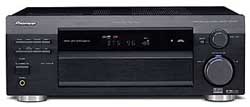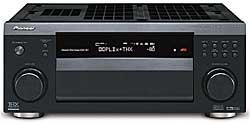|
Pioneer VSX-1014TX THX Select Certified Receiver
Pioneer VSX-1014TX Review
Introduction
I've had my eye on the Pioneer
VSX-1014TX for awhile, but had decided against it since it lacks a lip-sync
audio delay feature. But when the Best Buy
website had a one day sale price of $399 on the 1014, I thought I'd give it a
shot. I ordered online and picked it up at a local store.
I've been using a Pioneer
VSX-D912 for the past year, so the transition to the 1014 has been painless and
comfortable. The only problem encountered was with the size of the
VSX-1014. Measuring in at over 18 inches deep, the hefty 1014 would not
sit on the shelf in my entertainment center. Since my rack is open in the
back, I simply cut a 2-inch extension and attached it to the rear of the shelf
with a set of mending braces from my local ACE Hardware store.
The build quality is similar to my 912 but
larger, heavier, and more extensively ventilated. The back of the receiver
is well laid-out and secured with attractive copper screws. I was very happy
to discover that the caps on the speaker wire posts are longer than those on the
VSX-D912. With my old unit, the Dayton banana plugs would hang out
about a half inch from the back of the cap, and the weight of the 12 gauge wire
caused them to droop in a peculiar manner. With the post caps on the VSX-1014,
the Dayton plugs slide in fully and firmly with no droop.
|

|

|
|
The Pioneer VSX-D912 6.1
channel receiver |
The Pioneer VSX-1014TX 7.1
channel receiver |
Remote Control
I had grown very fond of the remote from the VSX-D912 and expected to be
disappointed with the VSX-1014 remote. Surprisingly, the remote included
with the 1014 is not bad at all. Though my old remote had a more ergonomic
design and contour, I've found the new remote to be simple and easy to
operate. I programmed it to operate my television, DVD
player, VCR, and CD player using a mixture of preset codes and the learning
function. Though the learning function is extremely handy, it can be
frustrating at times. On more than one occasion it took 5 or 6 tries
before it would accept a command without getting an "error" message on the small LCD
screen of the unit. The remote control is not backlit, but for a
receiver at this price point I have found it more than adequate.
|

|

|
|
Remote from the Pioneer
VSX-D912
Click photo for larger image. |
Remote from the Pioneer
VSX-1014TX
Click photo for larger image. |
Set-Up
The microphone included with the VSX-1014TX appears to be identical to that
included with the VSX-D912. The familiar noise bursts and tock-tock sounds utilized to set speaker size,
distance, and delay took a few minutes longer than the 912 as the more advanced
calibration system of the VSX-1014
listened to the frequency response of each speaker in the room and applied
equalization. Using the on-screen display menu I was able to review the
settings. With the help of a Radio Shack sound pressure meter and the receiver's test
tones, I made a few adjustments to the front speakers, which the MCACC system
had set a few decibels high. The SVS PB2-ISD subwoofer was set about 5
decibels too low for my tastes (I run it about 3 decibels 'hot') so I adjusted
it as well. I was pleased to find that with the VSX-1014 I could run the
test tones on one speaker at a time. With the 912, the test tones would
zip around the room leaving little time to check and set each individual
speaker. MCACC had set all my speakers to "large" with the
exception of the rear center channel (I run a 6.1 set-up). I found this
odd since all three of the surround speakers are identical Athena AS-R1 bipole
surrounds, but Pioneer does note that this is possible because of room features
and placement. The AS-R1s are only rated down to 80hz, so I reset them
all to small anyway. The speaker distances set by the MCACC system seemed
accurate so I left them alone.
Initial Sound Impressions
The first thing I noticed was that the sound from the surround speakers was
cleaner and stronger with the 1014 than it was with the VSX-D912. I have
analog cable TV and use the audio out jacks from my television to the
receiver. For watching TV, I find the 7 channel stereo mode (6 channel
mode on the 912) provides the best sound for this set-up. Right off
I could tell the sound from the surround speakers was improved, and the center
rear channel was putting out a lot more information than it had with the
VSX-912. The stereo separation was better overall as well. The
"all channels adjust" setting on the auto-eq system really seemed to
help the rears blend with the fronts and give a more
balanced sound to the system.
Music
While the VSX-912 is a great home theater receiver, music is not its strong
point. The VSX-1014TX is quite an improvement. The 912 never made
much of a statement in 2 channel listening, but the 1014 provides a solid 2
channel experience. Toggling between 'stereo' and 'direct' modes, I found
that 'direct' provides a much cleaner and richer sound from my Athena
AS-F2 floorstanding front speakers. Direct mode on the 912 never
seemed to provide any improvement over the 'stereo' mode.
Audio purists may scoff, but with the
under-achieving 2 channel sound of the VSX-912 I preferred listening to most CDs
in PLII Music mode. With the improved performance of the VSX-1014 this may
not be the case, but the PLIIx Music mode on the 1014 still provides an
entertaining alternative to 'direct' listening for some music. Again, the
stronger and cleaner performance of the surround speakers with the 1014 was
apparent immediately. The new features of PLIIx Music mode are fun to play
with, and the 'Panorama' setting adds an interesting element to live
performances like the "Steamroller" cut on James Taylor's Greatest
Hits CD.
The bass management of the VSX-1014 is a huge
improvement over that of the VSX-912. With the 912 I was never quite able
to get a proper subwoofer level for music - it was either lacking or boomy. The 1014 does a respectable job of blending
the subwoofer with the other speakers when listening to CDs. Using an 80hz
crossover, I found I preferred letting the SVS PB2-ISD handle the low stuff by
setting all speakers to small.
With the VSX-912 I always listened to
music with the 'loudness' function engaged to add some dynamics to the
music. This is not necessary with the 1014, and the 'loudness' function is
now only used as it was intended - for low volume listening. While I
preferred the 'all channels adjust' EQ setting for watching television, I found
I preferred the 'front align' setting with music, allowing the AS-F2s to do
their thing while MCACC equalized the center and surrounds to closer match the
sound of the F2s.
Last summer I auditioned
a Denon AVR-3805 for three weeks in my home, and I have to admit the Denon
is a much stronger performer with music. The soundstage is bigger, the
imaging spot-on, and it is cleaner and more dynamic at both high and low
frequencies. But then again, with tax and the 'optional' set-up microphone,
the cost of the Denon was $700 more than that of the VSX-1014TX.
Movies
I have always been impressed with the home theater performance of the
Pioneer VSX-D912. In fact, the main reason I returned the Denon was
because its home theater performance was not much better than the little
Pioneer, and I could not justify the price based on musical excellence
alone.
I put the VSX-1014TX through the gauntlet of
familiar DVDs - Saving Private Ryan, Finding Nemo, and The Fellowship
of the
Ring to name a few. Toying with the auto-eq settings, I discovered that
the 'all channels adjust' setting gave excellent movie performance - improving
the sound of the surrounds and reducing brightness on the front
soundstage. I again noted that bass performance is superior to that of the
912. The FOTR Moria scenes, for example, pounded my room with greater ferocity than
they did with the VSX-912. The shark,
submarine and Darla sequences in Nemo displayed similar improvements in bass
response. The LFE seems not only stronger, but tighter and more
controlled. Surround speaker sound is cleaner and more potent as well.
This was the first time I've tried a receiver
with THX processing, and I'm still experimenting with it. Engaging the THX
mode does make action sequences less fatiguing by reducing blare and brightness,
but at the expense of some fine details that get lost in the re-eq. For
example, the clang of swords and wooshing of passing arrows in the Fellowship
are tamed down to a much more enjoyable level, but at the expense of detail
clarity in subtle effects such as whispering winds, spraying water and rustling
fabrics. If the THX re-equalization was user adjustable on the fly (say on
a scale of 0 to 9) it would be an awesome feature.
Conclusion
I have read many good things on the forums about the VSX-1014TX, and it has
not disappointed me. I cannot imagine a finer A/V receiver for $399.
Yes, there are features such as lip-sync audio delay and a Pure Direct mode
that I would like to have, but for the money spent there is really nothing I can
find to complain about in this receiver.
Note: Pioneer has
announced that it will release
the VSX-1015TX in April 2005.
My
Home Theater page
Links:
Home Theater Forum thread on VSX-1014tx
Perfect Vision Review of the
Pioneer Elite VSX-52TX
Home Theater Magazine Review of the Pioneer Elite VSX-52TX
Questions or comments? Email
me at chas41363a@yahoo.com


|



